Evaluation of the National Disaster Mitigation Program
Final Report
Executive Summary
This report presents the results of the evaluation of the National Disaster Mitigation Program (NDMP).
What we examined
The purpose of the evaluation was to examine the relevance and performance of NDMP from its inception in 2015-16 to 2018-19. The NDMP was created in April 2015 to reduce the impacts of flood disasters on Canadians by focusing investments on significant, recurring flood risk and costs; and to facilitate private residential insurance for overland flooding. The NDMP has two components: The Mitigation Contribution Component (MCC) and the Targeted National Capabilities Component (TNCC).
What we found
Flood disasters are the most common and costly natural disasters affecting Canada. There is a continued need for a national approach to support investments in flood disaster mitigation.
The NDMP complements other federal programs that provide funding for mitigation projects such as the Public Safety Canada's Disaster Financial Assistance Arrangements Program and the Infrastructure Canada's Disaster Mitigation and Adaptation Fund.
There is a need for future mitigation programming to consider interplays between hazards to increase resilience in Canadian communities.
The MCC contributed to an increase in the number of Canadian communities that undertook mitigation investment projects. 363 projects were funded in 117 communities; mostly flood mapping and non-structural and structural mitigation projects. Challenges were found with regards to the ability of the MCC to invest the total allocated budget, and for some PTs and First Nations communities to fully participate in the program.
Administrative requirements and time limits for structural projects were seen as barriers.
Analysis of demographic data revealed that the NDMP funded communities with higher representation of vulnerable populations, such as seniors and Indigenous People.
The TNCC developed some of the planned mitigation tools including the Federal Flood Mapping Series and the National Emergency Management System. There is a continued need to further promote the utilization of these tools.
The TNCC conducted targeted awareness campaigns and hosted four Annual National Roundtables for Disaster Risk Reduction as part of the engagement activities; and advanced discussion on flood insurance across Canada. There is still a need to expand Canada's flood insurance market.
Recommendations
In the spirit of continuous improvement and the potential for future disaster mitigation programming, the Assistant Deputy Minister of the Emergency Management and Programs Branch should:
Administrative Improvements
- Consider taking measures to better align the program timelines and processes with the PTs, and to streamline administrative and reporting requirements to facilitate participation of all eligible recipients;
- Examine existing requirements for structural mitigation projects (stream 4), including exploring potential options relating to the time limit, to ref projects, including the 24 month time limit to reflect the realities in planning and completing structural mitigation;
- Further promoting the use of the national risk and resilience tools and repository among relevant audiences.
Future Mitigation Programs
- Explore policy options to support all-hazards mitigation efforts to reduce disaster risks and related recovery costs across Canada.
Management Action Plan
Program Management accepts all recommendations and will implement an action plan.
1. Overview and Background
The National Disaster Mitigation Program (NDMP) was created in April 2015 to address the increasing risks and costs associated with flood disasters in Canada. The NDMP is comprised of two main components:
- Mitigation Contribution Component (MCC) provides financial support to provinces (up to 50%) and territories (up to 75%) for cost-shared projects in four stream of eligible activities:
- Flood Risk Assessment (stream 1);
- Flood Mapping (stream 2);
- Flood Mitigation Planning (stream 3); and
- Non-structural and small-scale structural measures (stream 4).
- Targeted National Capabilities Component (TNCC) helps in building the foundation for future mitigation efforts by investing in three key areas:
- National risk and resilience and return on investment tools;
- National risk and resilience repository; and
- National public awareness and engagement activities.
2. Evaluation Purpose and Methodology
The evaluation assessed the relevance and performance (effectiveness and efficiency) of the NDMP from its inception in 2015-16 to 2018-19; and sought to identify lessons learned during the design and implementation of the program as well as best practices to enhance Canada's approach to flood disasters.
2.1 Lines of Evidence
Data collection for this evaluation included the following lines of evidence:
Interviews: Thirty-five interviews were conducted with program representatives, federal partners and external representatives including Provincial government representatives and subject matter experts.
Literature and document review: This included academic research, media publications, public reports, and corporate documents (inception, policy and program documents).
Review of financial and performance data: The evaluation analyzed the financial information, examined the program and funded projects performance data.
2.2 Limitations
The evaluation team did not contact communities where the mitigation projects took place, as Public Safety did not deal directly with communities, but rather with the Provincial or Territorial governments (PTs). The evaluation team attempted to contact all PT representatives. Some PT representatives were not available at the time of this evaluation; in these cases, the evaluation team relied on project documents and other documents to establish findings.
3. Findings
3.1 Relevance
3.1.1 Continued Need
Finding: There is a continued need for a national approach to support investments in flood disaster mitigation measures. Future mitigation programming should consider interplay between hazards to increase resilience in Canadian communities.
Floods disasters are the most common natural disasters affecting Canadian communities, and among the most costly. Between 2008 and 2018, the Canada Disaster Database recorded 170 major disasters resulting in tens of billions of dollars in damages, of these 108 were flooding incidents, including flooding from major storms.
Since 1970, the Government of Canada has paid out $5 Billion in post-disaster assistance through the Disaster Financial Assistance Arrangements (DFAA) to help Provinces and Territories with response and recovery costs. Half of this amount has been paid out in the last five years, which shows that disasters are increasing in both numbers and costs. Many have attributed this increase to climate change. Flood disasters have accounted for almost 75% of DFAA events and 2/3 of all DFAA payments.
Figure 1: Natural Disasters in Canada between 2008 and 2018*
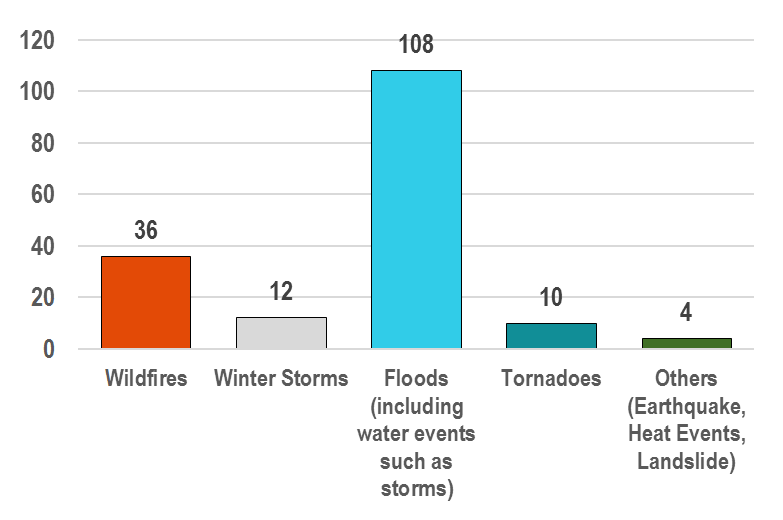
*Excluding Biological Events
Image description
This graph presents the number of natural disasters by type of natural disasters
36: wildfires
12: winter storms
108: Floods (including water events such as storms)
10: Tornadoes
4: Others (Earthquake, Heat Events, Landslide)
There continues to be a need for risk assessment, flood mapping and flood forecasting. These provide jurisdictions with the foundational knowledge required to move forward with non-structural and small-scale structural mitigation measures.
Mitigation measures offer significant returns on investment. For every $1 invested in mitigation efforts, $7 to $10 can be saved in post-disaster recovery costs.
Without the NDMP, there would be a significant gap in funding for small-scale structural and non-structural mitigation measures. PT representatives stated that a lack of federal contribution would make it hard for communities to undertake flood mitigation projects. Many small communities do not have the resources available to complete mitigation projects on their own. It was noted that the NDMP helped small communities to complete projects that they could not have done without the program.
While there was support for flood disaster mitigation, the majority of interviewees highlighted the need for an all-hazards program. This was considered important given the interplay between disasters, as well as the different hazards across the country.
Quote: "When there are forest fires, we know that we're going to get more floods in coming years."
3.1.2 Complementarity
Finding: NDMP complements other federal programs that provide funding for mitigation projects; however, there are opportunities for closer engagement with these programs.
A number of other federal programs are aimed at supporting disaster mitigation nationally. NDMP complements these programs by funding activities that are not covered, and by providing funding specific to flood mitigation. No other federal programs provide dedicated funding for jurisdictions to conduct flood mapping or flood risk assessments. A full list of programs is available in Annex B.
The other major funding programs for disaster mitigation are Public Safety's Disaster Financial Assistance Arrangements (DFAA) program and Infrastructure Canada's Disaster Mitigation and Adaptation Fund (DMAF).
The DFAA allows for 15% of funds to be spent on mitigation enhancements after a disaster occurs, while NDMP focuses on mitigating before a disaster.
DMAF aims to strengthen the resilience of Canadian communities through investments in large-scale infrastructure projects. DMAF projects must have a minimum of $20 million in eligible expenditures while NDMP focuses on small-scale infrastructure mitigation projects. The maximum federal contribution for small-scale structural projects (stream 4) under the NDMP is $1.5 million for provinces and $2.25 million for territorial projects.
There are several other infrastructure funding programs that are also complemented by the NDMP. These programs have mitigation as an eligible category and are not specifically dedicated to infrastructure for disaster mitigation. NDMP is the only federal program fully dedicated to flood disaster mitigation. For instance, Infrastructure Canada's Provincial-Territorial Infrastructure Component (PTIC) provides support for projects of national, local or regional significance. This includes the $1 billion Small Communities Fund (PTIC–SCF) to provide financial support to projects in municipalities with fewer than 100,000 residents. This program has been in place since 2014-15.
There is a continued need for PS and Infrastructure Canada to work together to review structural mitigation proposals under NDMP.
3.2 Performance
3.2.1 Mitigation Contribution Component (MCC)
Finding: The MCC contributed to an increase in the number of Canadian communities that undertook mitigation investment projects to reduce their vulnerability to flood disasters. There was an increase in the number of projects proposed and funded each year. Challenges were found with regard to the ability of some PTs and First Nation communities to fully participate.
The MCC provides funding to Provinces and Territories for flood mitigation investments, under four streams:
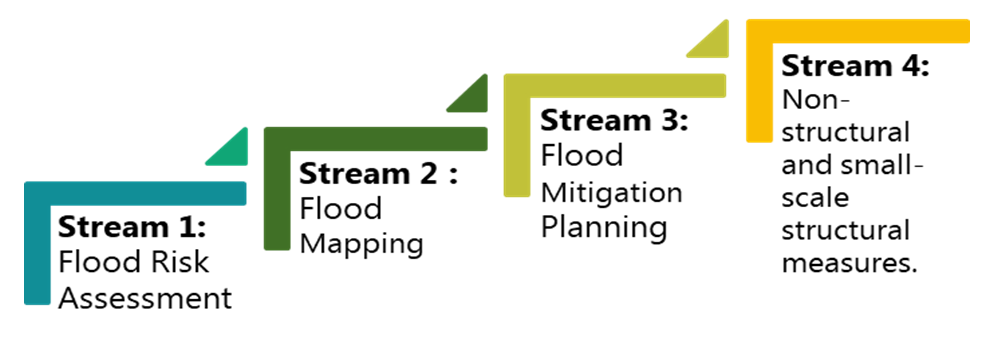
Image description
Stream 1: Flood Risk Assessment
Stream 2: Flood Mapping
Stream 3: Flood Mitigation Planning
Stream 4: Non-structural and small-scale structural measures
Projects must demonstrate that they build on the previous streams. For example, applications for mitigation planning must have demonstrated that their proposals reflect a need to prevent or mitigate identified and significant flood risks, and are based on up-to-date flood mapping.
All projects were cost shared. The maximum federal contribution amount for eligible small-scale structural projects (Stream 4) was $1.5 million for provinces and $2.25 million for territorial projects.
The MCC had provisions to allow on-reserve First Nations to utilize the Crown-Indigenous Relations and Northern Affairs Canada (CIRNAC) mitigation funding to contribute the Provincial or Territorial portion of the funding. In this case, the overall federal contribution could be up to 100%.
The MCC led to an increased number of flood mitigation investment projects. NDMP funded 363 projects that benefited 117 communities. The majority of funded projects under the MCC were for flood mapping and non-structural and structural mitigation measures.
Flood mapping is an important tool that helps homeowners to know the risks they are exposed to, and municipalities to take the appropriate flood mitigation measures. Flood mapping was among the pre-conditions set by the insurance industry to be able to provide affordable flood insurance.
NDMP funded 104 non-structural (NS) and small-scale structural (SSS) mitigation measures under stream 4. In order for communities to be funded for stream 4 projects, they must have completed risk assessments, flood mapping and mitigation planning. This shows that the recipient communities mitigated their flood risks by completing all four streams of the NDMP.
Figure 2: Percentage of Funded Projects by Stream
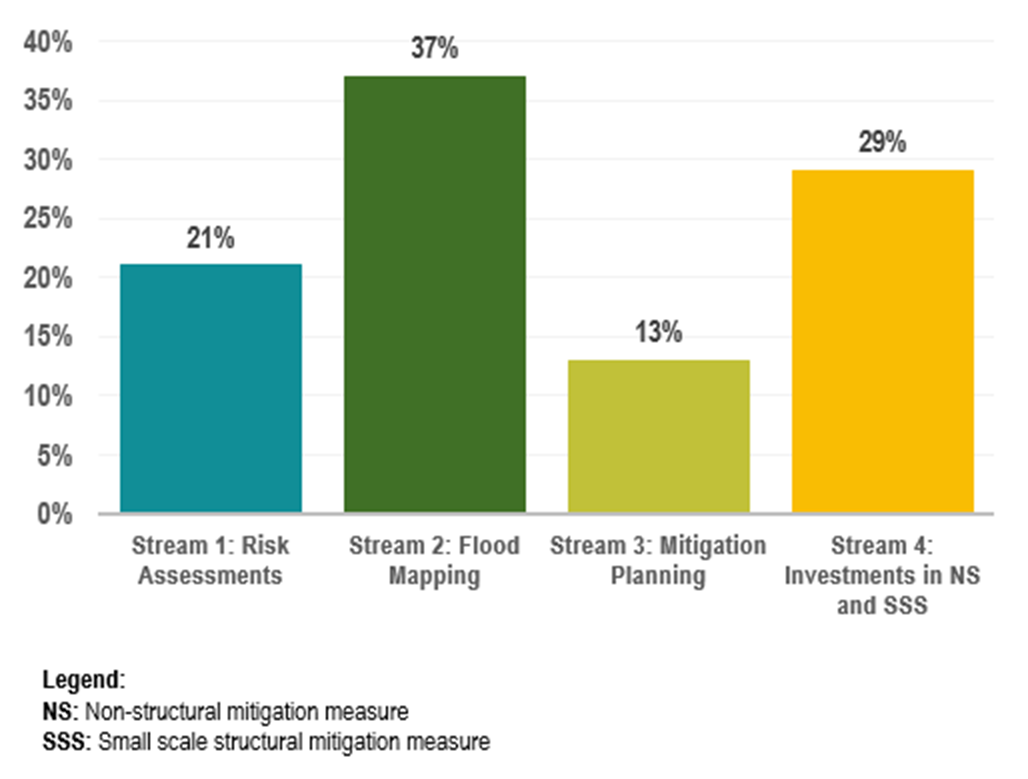
Image description
This graph presents the percentage of fund projects by stream
There were 21% of funded projects for Stream 1 (Risk Assessments)
There were 37% of funded projects for Stream 2 (Flood Mitigation)
There were 13% of funded projects for Stream 3 (Mitigation Planning)
There were 29% of funded projects for Stream 4 (Investments in Non-structural and small-scale structural measures)
The number of proposals received and funded by Public Safety has consistently increased since the start of the program in 2015-16. In fact, almost five times more projects were funded in the first half of 2019-20, than were funded in 2015-16.
Provincial interviewees and supporting documentation indicated that there was low uptake of the program in the first two fiscal years, as timing of the launch did not align with the provincial budget cycles, and many jurisdictions were not able to commit the matching funds necessary. In addition, PTs anticipated an all-hazards program, and as a result, may have had to modify projects to focus on flood mitigation.
Stream 4 projects were required to be completed within 24 months. Some projects were not approved for funding in the last year of the program, as they did not meet this requirement. As many structural mitigation projects require construction contracts or are dependent on appropriate weather conditions, delays are to be expected.
Figure 3: Project Proposals and Funded Projects
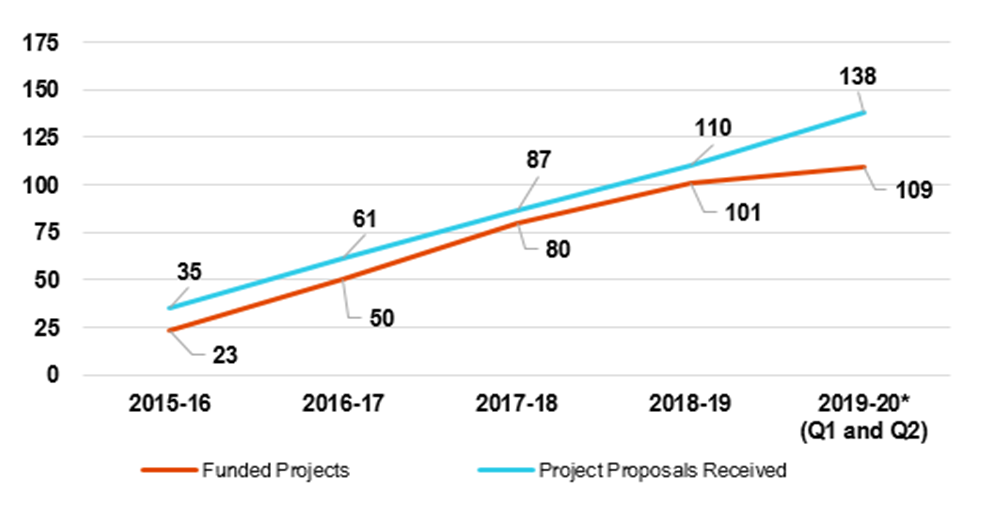
Image description
This graph presents the number of projects proposals received and the number of funded projects by fiscal year
In 2015-16 there were 35 projects proposals received and the program funded 23 projects
In 2016-17 there were 61 projects proposals received and the program funded 50 projects
In 2017-18 there were 87 projects proposals received and the program funded 80 projects
In 2018-19 there were 110 projects proposals received and the program funded 101 projects
In 2019-20 (Q1 and Q2) there were 138 projects proposals received and the program funded 109 projects
Of the 363 funded projects, 189 were in Ontario. These projects accounted for $39.78 million, which represents almost 42% of the total amount funded by the MCC. British Columbia had the next highest number of projects with 82 projects costing $22.4 million, which represents 24% of the total amount funded.
It is important to note that funding was not intended to be allocated equally across the country. Project proposals were assessed on quality and feasibility.
As there was no agreement signed with the government of Quebec, no projects were funded in the province. Nunavut did not receive funding, as flood disasters do not impact the territory.
Figure 4: PTs Map of Funded Projects

Image description
The image represents the total number funded projects and the amount received per PT
For YT there were 3 projects funded projects and received $1.12M
For NT there were 2 projects funded projects and received $0.49M
For BC there were 82 projects funded projects and received $22.4M
For AB there were 34 projects funded projects and received $10.1M
For SK there were 5 projects funded projects and received $0.82M
For MB there were 3 projects funded projects and received $2.2M
For ON there were 189 projects funded projects and received $39.78M
For NB there were 15 projects funded projects and received $9.22M
For NS there were 19 projects funded projects and received $5.87M
For PE there were 7 projects funded projects and received $1.7M
For NL there were 4 projects funded projects and received $1.1M
First Nation communities faced additional barriers in accessing NDMP funding. All applications for funding had to be submitted through provincial or territorial governments. Given the federal responsibility for on-reserve communities, this approach was raised as an issue. In some instances, First Nations communities faced challenges in obtaining support through the application process.
First Nation communities could apply for funding from Crown-Indigenous Relations and Northern Affairs Canada (CIRNAC) to match the NDMP contribution. However, the timing of the funding approvals between Public Safety and Crown-Indigenous Relations and Northern Affairs Canada did not align. Communities required confirmation of funding support from CIRNAC prior to the Province or Territory submitting proposals under the NDMP. This caused additional impediments to accessing funding.
Another challenge was with the reporting. The Provincial and Territorial governments were responsible for reporting on all projects within their jurisdiction, even if they didn't provide the matching funds. In some instances, First Nation communities partnered with another municipality to overcome these hurdles.
Quote: "There are communities where they're not close to a municipality so they would rather design mitigation that protected them completely."
Quote: "They can manage their own mitigation in a culturally appropriate way."
Finding: There were challenges with regards to the ability of the MCC to invest the total allocated budget in mitigation projects.
NDMP inception documents indicated that the MCC was allocated $183.8 million in contribution funding for the evaluation period. The MCC funded 363 projects for $94.8 million, which represents only 52% of the total allocated budget.
Various reasons were provided to explain the funding gap. These include the lack of alignment with the NDMP call for proposals and PTs' budget cycle; the low uptake during the first two rounds of funding; and delays encountered with funding approval. Most Provincial and Territorial representatives stated that PS did not meet its approval timelines, which resulted in project delays. In addition, there was no agreement signed with the province of Quebec. As a result, no projects were funded in the province, which also limited the ability of the MCC to invest the allocated budget. The remaining funds (48%) were either reprofiled to future years of the program, reallocated to other departmental priorities or returned to Treasury Board Secretariat.
Figure 5: Total Budgeted and Approved Funding Per Fiscal Year
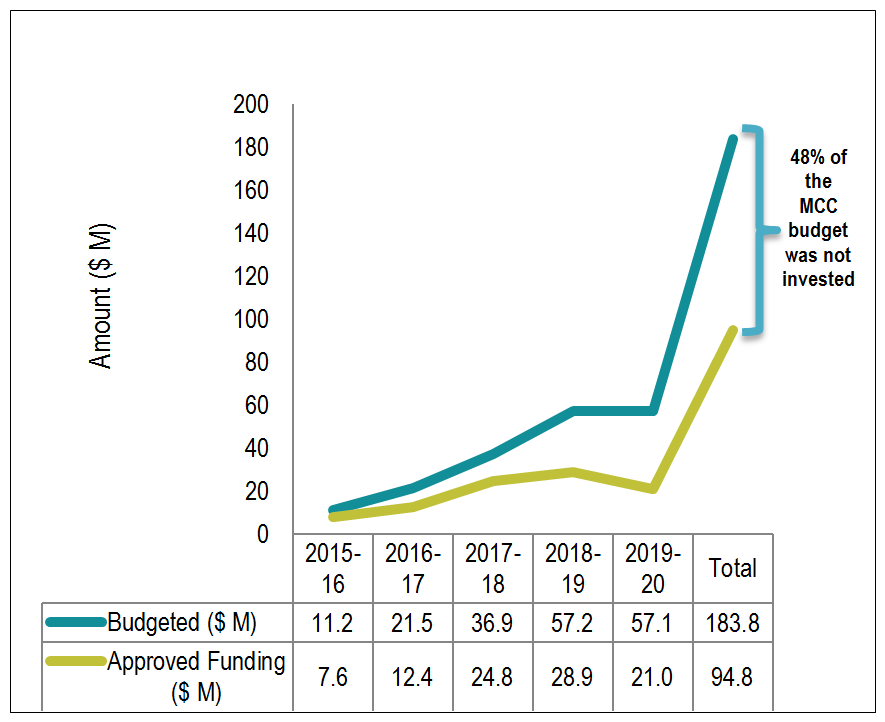
Note: Figures may not add up due to rounding.
Image description
This graphs represents the total budgeted and Approved funding per fiscal year
In 2015-16 the total budgeted was $11.2M and the approved funding was $7.6M
In 2016-17 the total budgeted was $21.5M and the approved funding was $12.4M
In 2017-18 the total budgeted was $36.9M and the approved funding was $24.8M
In 2018-19 the total budgeted was $57.2M and the approved funding was $28.9M
In 2019-20 the total budgeted was $57.1M and the approved funding was $21.0M
Total budgeted was $183.8M and the program spent $94.8M
48% of the MCC budget was not invested.
The majority of federal partners and Provincial and Territorial representatives found the MCC project selection process to be effective and fair. The inclusion of Provincial and Territorial representatives as observers on the review panel was viewed positively.
However, some concerns were raised with the project proposal forms. They were found to be lengthy and challenging to complete. As well, the lack of an explanation for rejected proposals was perceived negatively. Some representatives stated that if rationale on unsuccessful projects was available, they would have been able to address the concerns in future applications.
Overall, the administration of MCC is complex and burdensome on both the recipients and Public Safety staff. Projects administered by a PT were combined into a single funding agreement with Public Safety. As a consequence, if an amendment was required for a specific project, it would need to be applied to each project covered under the agreement. As some provinces had over 100 projects, this placed unnecessary pressures on administrative resources for reporting, particularly the cash flow reporting.
Limited resources and significant staffing turnover in the regions and at PS headquarters during the early stages were identified as factors that negatively impacted the administration of the program. This was further exacerbated by a lack of training for PS personnel in the regional offices.
To address some of the administrative burdens, in 2018-19 the program modified some of its processes and piloted these changes with the province of Ontario. The revised approach allowed for amendments to remain exclusive to the projects for which they were required. As well, project-level reporting was replaced by agreement-level reporting. These changes were intended to provide more flexibility to recipients and improve overall efficiency.
The changes have been received positively. Additional administrative improvements were attributed, by interviewees, to changes in management. These improvements included a streamlined approval committee process, greater consultation with the regional offices as well as additional training and tools for regional officers.
Despite these modifications, Provincial and Territorial representatives have identified additional areas that require improvement. These include the project approval timelines and a streamlined application form.
Quote: "To reduce administrative burden, the program piloted with Ontario, an approach to manage at agreement level instead of project level."
Finding: Although the TNCC developed some of the planned mitigation tools, there is a continued need to further promote their utilization and to continue discussions to expand the Canadian overland flooding insurance market.
3.2.2 The Targeted National Capabilities Component (TNCC)
The TNCC aimed to assist future flood disaster mitigation efforts by:
- developing national risk, resilience and return on investment tools;
- establishing a national risk and resilience repository to support an aggregated national risk profile; and
- conducting national public awareness and engagement activities and advancing the discussion on overland flooding insurance.
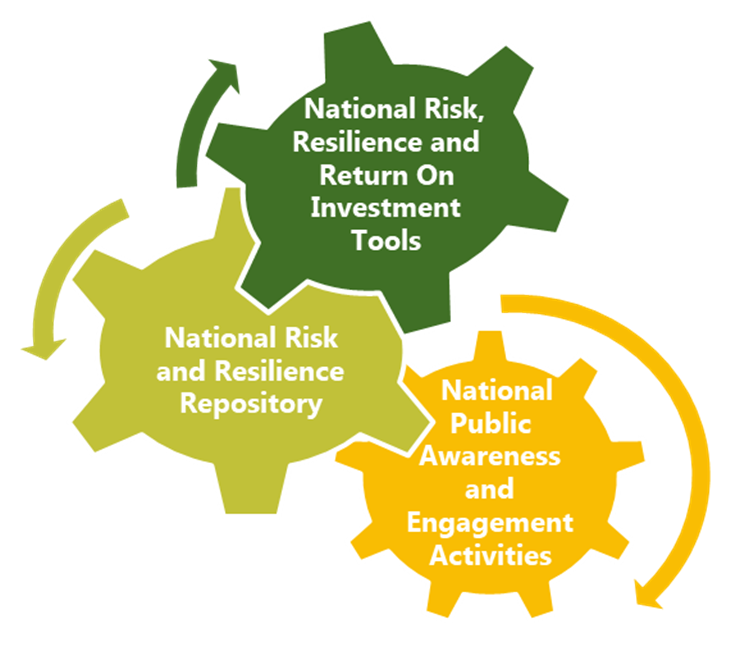
Image description
National Risk, Resilience and Return On Investment Tools
National Risk and Resilience Repository
National Public Awareness and Engagement Activities
National risk and resilience tools
Through the Targeted National Capabilities Component of the NDMP, 17 tools and studies related to national risk and resilience were developed between 2016-17 and 2018-19.
These include the Federal Flood Mapping Guidelines Series developed in consultation with PTs and key stakeholders, and the National Risk Profile Pilot. No tools or studies related to the return on investment for flood mitigation were found.
The Guidelines promote common approaches to floodplain mapping across Canada.
National risk and resilience repository
The TNCC launched the National Emergency Management System (NEMS) in 2017-18. NEMS is a digital toolbox and collaborative space for emergency management practitioners. NEMS helped improve data collection, information sharing and collaboration among stakeholders. Seventeen user communities have been created in the system. Between 2017-2018 and 2018-2019, 2047 documents were uploaded to NEMS.
Some Provincial and Territorial representatives found the tools and NEMS very useful. However, most of them were unaware of these resources and suggested they should be better promoted.
Public Awareness
Over the evaluation period, the NDMP conducted targeted campaigns with provincial and municipal stakeholders and digital outreach through the national Flood Ready Awareness campaign. It was advertised on YouTube, Facebook, Twitter, the Weather Network website and floodready.ca.
This campaign targeted Canadian households with the objective to shift behaviors from disaster response to mitigation and to encourage Canadian homeowners and community leaders to take action.
Quote: "Only 6% of homeowners know they are located in a designated flood risk area and only 21% believe that the risk of flooding will increase over the next 25 years."
– University of Waterloo's Centre on Climate Change, 2017.
Overall, digital advertising had a strong reach. For instance, in spring 2019, the Weather Network hosted a Facebook live event which delivered over 1.1M impressions or views.
The majority of interviewees indicated that these campaigns contributed to an increased awareness among the targeted groups about flooding. However, they also noted that there may be a continued need for federal campaigns to educate Canadians about flood risk mitigation. The evaluation did not find specific data on changes in behavior.
Engagement activities
The TNCC hosted four Annual National Roundtables for Disaster Risk Reduction during the evaluation period, with 863 total participants. These Roundtables bring together stakeholders from a broad cross-section of society, including the public sector, the private sector, academia, non-governmental and not-for-profit organizations, professional associations, and Indigenous peoples. They also provided a valuable opportunity for discussion on the United Nations' Sendai Framework for Disaster Risk Reduction. Canada has been a signatory of the Framework, since the original version in 1995.
The Roundtables were delivered in four different provinces: Alberta, Quebec, Nova Scotia and British Columbia. Participants indicated overall satisfaction with the events as reported in post-event surveys.
Private residential insurance for overland flooding
In 2015, Canada was the only G7 country with no residential insurance coverage for overland flooding as existing flood maps were outdated. The insurance industry began to offer overland residential flood insurance for certain areas in late 2015.
In order to offer widespread private insurance for homeowners against flood-related disasters, the insurance industry asked government to meet certain pre-conditions, including flood risk assessments and national floodplain mapping. The NDMP was created, in part, to meet those pre-conditions.
Interviewees stated that NDMP outputs have been leveraged to improve insurance industry models. Flood maps funded by the NDMP have been utilized by the insurance industry. However, at present, affordable overland flood insurance is not available to all affected communities across Canada.
4. Gender Based Analysis Plus (GBA+)
Finding: While the NDMP was created to assist communities based on their vulnerability to flood risk, the program has funded projects in communities with a higher representation of certain vulnerable populations
Natural disasters do not affect people equally. For instance, reduced mobility could make elderly people more at risk during a flood disaster, which is also true for people with disabilities.
The Government of Canada has recognized the need to address these inequities. Budget 2019 provided $5 million over five years for PS to develop all-hazard awareness-raising activities for at-risk audiences such as seniors, Indigenous peoples, recent immigrants, people with disabilities, and low-income Canadians.
While the NDMP targeted communities based on their flood risk, analysis of the demographic data revealed that the NDMP provided funding to communities with higher representation of vulnerable populations, such as elderly and Indigenous peoples. Future disaster mitigation programs could include specific measures to address the needs of vulnerable populations.
Figure 6: Socio-Demographic Profile of Communities
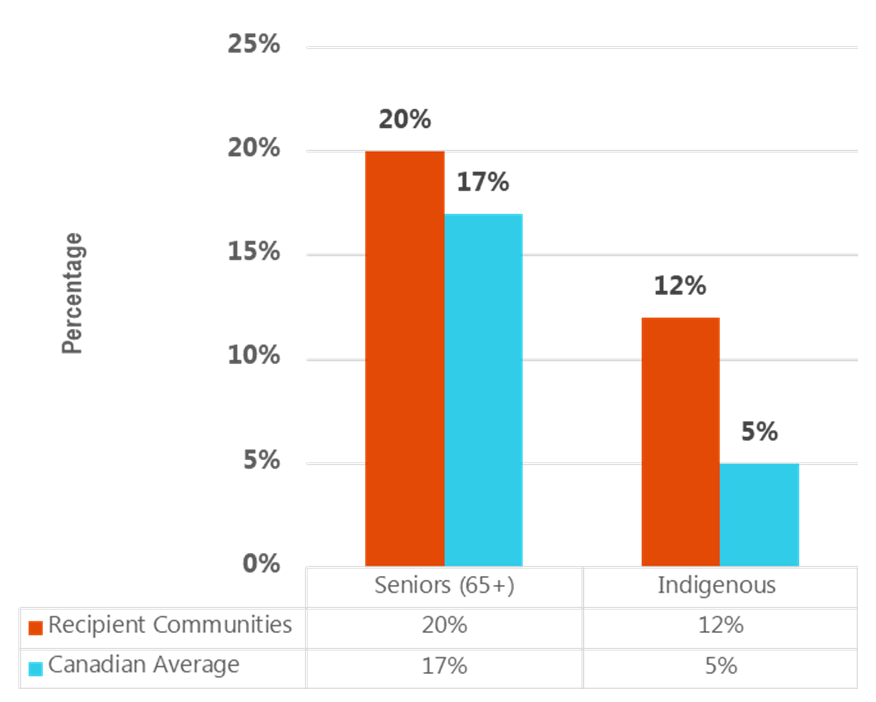
Image description
This graphs demonstrates the comparison between the population in recipient communities and the overall Canadian population.
Among recipients communities funded by NDMP, 20% were seniors (65+) compare to 17% of Canadian average.
Among recipients communities funded by NDMP, 12% were indigenous population compare to 5% of Canadian average.
5. Lessons Learned
Design
The NDMP's limited focus on flood mitigation negatively impacted the relationship with PTs. They would have preferred a program with broader natural disaster coverage. Interviewees noted that there should be more collaboration with those that deliver the programs on the ground.
Concerning performance measurement of the MCC, interviewees indicated that it can be challenging to measure the effectiveness of mitigation projects in the short term, as the impacts may only be realized after a disaster occurs. It was also noted that the project reporting requirements were more focused on cash flow and financial documents than on a project's results and efficiency.
Implementation
The timing of the NDMP's launch may have contributed to low uptake among PTs since it was launched after their budget cycle and as a result, matching funds were unavailable.
Interviewees indicated that small-scale structural mitigation projects are complex by nature and require more time to implement than is currently allowed for by the NDMP (maximum 24 months). They suggested a more flexible approach for their implementation.
6. Best Practices
Finding: There is a need for a whole-of-society approach to implement effective and cost-efficient ways to achieve the objectives of the NDMP and reduce the fiscal burden on PTs and the federal government related to disaster recovery.
Eighty percent of Canadian cities are built on flood plains. With climate change, recovery costs for flood disasters will continue to increase.
To reduce the fiscal burden stemming from flood disasters, there is a need for a whole-of-society approach. Governments, homeowners, private sector, academia and NGOs all have a role to play.
Local jurisdictions and homeowners are at the frontline of flood disaster mitigation. There are effective and cost-efficient measures that could be implemented at these levels to help reduce fiscal burden on PTs and the federal government.
Figure 7: Measures to Reduce and Transfer Flood Disaster Risks*
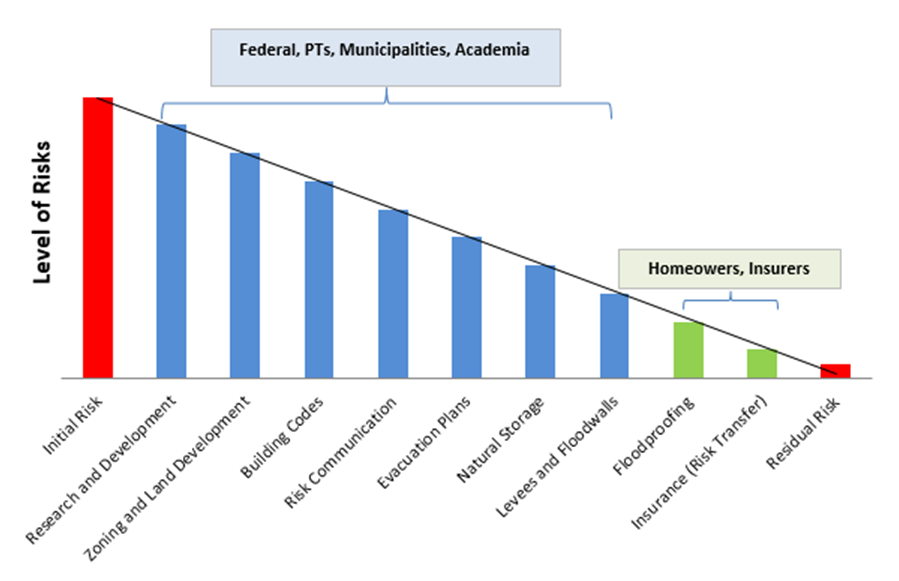
*Adapted form The Levees and the National Flood Insurance Report
Image description
This graph illustrates examples of tools and measures to reduce and transfer flood disaster risks. The tools and measures are: Research and Development, Zoning and Land Development, Building Codes, Risk communication, Evacuation Plans, Natural Storage, Levees and Floodwalls, Floodproofing, Insurance (Risk Transfer). Some of actions are taken at the federal, PTs, Municipalities and Academia, whereas others are taken by homeowners and insurers. The risk that remains after these tools and measures are taken is the residual risk.
Zoning and Land Development
Better management of zoning and land development would reduce the risk of flood disasters. This could be supported by risk assessments and flood mapping funded by the NDMP. This is one of the most effective and cost-efficient way to reduce the financial impacts, as flood disasters occur because of the intersection of flooding with vulnerable populations and assets.
Preventing land development in flood-prone areas is adopting a (near?) zero risk approach which, in turn, would contribute to reducing the fiscal burden at all levels of government. Within Canada, zoning decisions are the responsibility of municipalities. Considering flood mitigation in land use decisions could be encouraged through incentives, as is done in the United Kingdom.
Flood Proofing
There are a number of small and cost-effective measures that property owners can take to considerably reduce the risk of flooding outside and inside their houses or buildings.
The top flood risks identified outside a property are window wells installation below 4-6" above grade and downspout discharge installation less than 2 meters from the property. Inside a property, the top risks identified are the absence of back-up sump pump and/or no sump pump back-up power.
Flood proofing 100,000 properties would cost approximately $4.5 million which represent an average of $45 per property. Future disaster mitigation programs could support investment in private mitigation measures, such as those highlighted in the Flood Ready awareness campaign.
7. Conclusions
The NDMP fills a continuing need for a national approach to flood disasters mitigation. Continued investments in flood mitigation and a comprehensive all-hazards approach will help reduce disaster response and recovery costs in Canada. The NDMP complemented other federal programs with a disaster mitigation component.
Although the NDMP contributed to an increased number of mitigation investments to reduce vulnerability to flood disasters in Canadian communities, challenges were found with the ability of all PTs to participate in the program.
The NDMP developed tools to help communities to take actions to reduce their vulnerabilities to flood risks. However, there is a need to further promote the utilization of these tools among targeted users. In addition, the Program helped increase awareness and engagement among Canadians stakeholders on flood disasters.
It also contributed to improving the current insurance industry model for residential flood insurance. However, progress is still needed to enable a viable and affordable flood insurance market across Canada.
With Climate change and considering that 80% of Canadian cities are built on flood plains, mitigation efforts, spanning all levels of government, Canadians, private sector, academia, and Indigenous communities are still required to fully address flood disaster across Canada.
8. Recommendations
In the spirit of continuous improvement of the NDMP and the potential for future disaster mitigation programs, the Assistant Deputy Minister of the Emergency Management and Programs Branch should:
Administrative Improvements
- Consider taking measures to better align any future disaster mitigation program timelines and processes with the PTs, and to streamline administrative and reporting requirements to facilitate participation of all eligible recipients;
- Examine existing requirements for structural mitigation projects (stream 4) including exploring potential options relating to the time limit, to reflect the realities in planning and completing structural mitigation projects;
- Further promoting the use of the national risk and resilience tools and repository among relevant audiences.
Future Mitigation Programs
- Explore the policy options to support all-hazards mitigation efforts to reduce disaster risks and related recovery costs across Canada.
9. Management Action Plan
Recommendation |
Action Planned |
Planned Completion Date |
|---|---|---|
1. Consider taking measures to better align any future disaster mitigation program timelines and processes with the PTs, and to streamline administrative and reporting requirements to facilitate participation of all eligible recipients. |
The NDMP sunsets on March 31, 2020. If extended for a short period, minor administrative amendments to the program's Terms and Conditions (T&C) will be considered |
March 31, 2021 |
2. Examine existing requirements for structural mitigation projects (stream 4), including exploring potential options relating to the time limit, to reflect the realities in planning and completing structural mitigation. |
The NDMP sunsets on March 31, 2020. If extended for a short period, minor administrative amendments to the program's Terms and Conditions (T&C) will be considered. |
March 31, 2021 |
3. Further promote the use of the national risk and resilience tools and repository among relevant audiences. |
EMPB will begin delivering the National Risk Profile (NRP) project. The NRP will include products, tools and activities designed to increase risk awareness and information sharing among relevant groups and the emergency management community across the country. |
December 31, 2021 |
4. Explore policy options to support all-hazard mitigation efforts to reduce disaster risks and related recovery costs across Canada. |
Informed by results and lessons from the NDMP, as well as a review of the Disaster Financial Assistance Arrangements (DFAA), EMPB will consider potential options and next steps for federal disaster mitigation programming and disaster risk reduction. |
March 31, 2022 |
Annex A: Logic Model
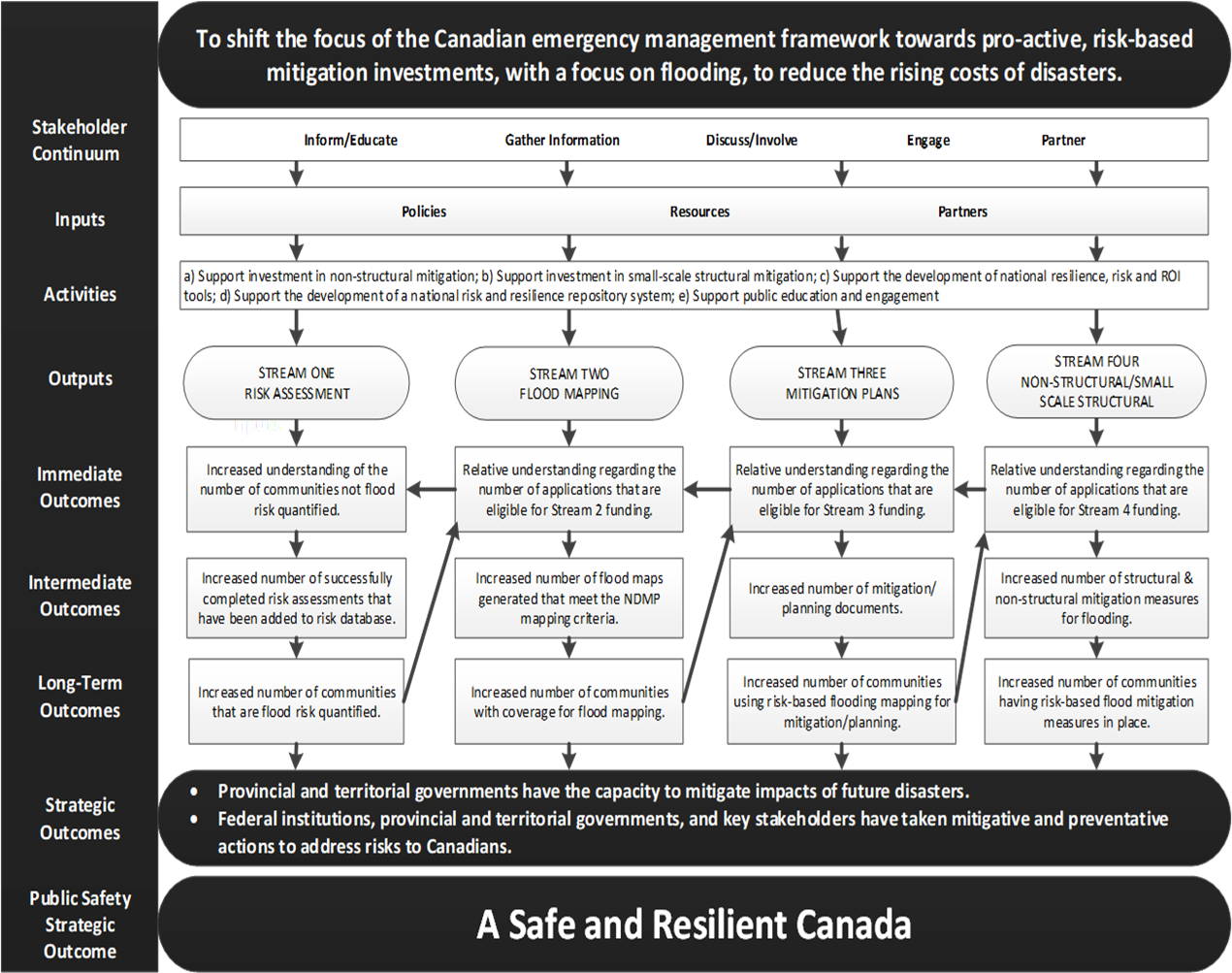
Image description
To shift the focus of the Canadian emergency management framework towards pro-active, risk-based mitigation investments, with a focus on flooding, to reduce the rising costs of disasters.
The Stakeholder Continuum are:
- Inform/Educate
- Gather Information
- Discuss/Involve
- Engage
- Partner
The inputs are:
- Policies
- Resources
- Partners
These inputs lead to the activities are: a) Support investment in non-structural mitigation; b) Support investment in small-scale structural mitigation; c) Support the development of national resilience, d) risk and ROI tools; e) Support the development of a national risk and resilience repository system; f) Support public education and engagement
These activities lead to the outputs of:
- Stream one: Risk assessment
- Stream two: Flood mapping
- Stream three: Mitigation plans
- Stream four: Non-structural/small scale structural
These outputs lead to the Immediate Outcomes of:
- Increased understanding of the number of communities not flood risk quantified
- Relative understanding regarding the number of applications that are eligible for Stream 2 funding
- Relative understanding regarding the number of applications that are eligible for Stream 3 funding
- Relative understanding regarding the number of applications that are eligible for Stream 4 funding
These intermediate Outcomes lead to the Intermediate Outcomes of:
- Increased number of successfully completed risk assessments that have been added to risk database
- Increased number of flood maps generated that meet the NDMP mapping criteria
- Increased number of mitigation/planning documents
- Increased number of structural & non-structural mitigation measures for flooding
The Intermediate Outcomes lead to Long-Term Outcomes of:
- Increased number of communities that are flood risk quantified
- Increased number of communities with coverage for flood mapping
- Increased number of communities using risk-based flooding mapping for mitigation/planning
- Increased number of communities having risk-based flood mitigation measures in place
These Long-Term Outcomes lead to Strategic Outcomes are:
- Provincial and territorial governments have the capacity to mitigate impacts of future disasters.
- Federal institutions, provincial and territorial governments, and key stakeholders have taken mitigate and preventative actions to address risks to Canadians.
The Public Safety Strategic Outcome is:
- A Safe and Resilient Canada
Annex B: Federal Programs that complement the NDMP
Program |
Eligible Category |
Allocated Budget |
Funding Level |
Cost-Shared |
Recipients |
Target Population |
|---|---|---|---|---|---|---|
National Disaster Mitigation Program (PS) |
Flood Mitigation |
$200 million |
Maximum $ 3 million |
50% P 75% T |
PT |
Canadian communities |
Disaster Financial Assistance Arrangements (PS) |
Response, recovery and mitigation/ All Hazards |
No maximum allocated budget (15% mitigation component) |
N/A |
50% P 75% T |
PT |
Canadian communities |
Disaster Mitigation Adaptation Fund (Infrastructure Canada) |
Infrastructure for disaster mitigation |
$2 billion over 10 years |
Minimum $20 million |
50% P , 75% T and Indigenous recipients 40% municipality and not-for-profit 25% for-profit |
PT, Indigenous recipients Municipalities and regional governments Not-for-profits organizations For-profit organizations |
Canadian communities |
New Building Canada: Provincial –Territorial Infrastructure Component (Infrastructure Canada) |
Infrastructure for disaster mitigation |
$10 billion (this includes $1 billion for small communities) |
N/A |
33.33% P |
PT |
Canadian |
Federal Gas Tax Fund (Infrastructure Canada) |
Infrastructure for disaster mitigation |
$ 2 billion per year |
N/A |
No |
PT |
Canadian communities |
Green Infrastructure Stream of the Investing in Canada Plan (Infrastructure Canada) |
Adaptation, Resilience, Disaster Mitigation |
$9.2 billion over 10 years |
N/A |
50% P , 75% T and Indigenous recipients 40% municipality and not-for-profit 25% for-profit |
PT , Indigenous recipients Municipalities and regional governments Not-for-profits organizations For-profit organizations |
Canadian communities |
First Nations Adapt Program (Crown-Indigenous Relations and Northern Affairs Canada) |
Mitigation and Climate change |
2017-18 : $27 million over five years for flood mapping |
N/A |
No |
First Nations communities, Band or Tribal councils, and Indigenous organizations |
First Nation communities |
First Nation Infrastructure Fund – Structural Mitigation (Crown-Indigenous Relations and Northern Affairs Canada) |
Infrastructure for disaster mitigation |
$40M over 5 years starting 2015/16 |
Up to $10M per recipient per year |
No |
FN communities, Band or Tribal councils, Indigenous organizations, and private/public groups (if the primary beneficiary is a FN community) |
First Nation communities |
Emergency Management Assistance Program (Indigenous Services Canada) |
Mitigation, preparedness, response and recovery |
Ongoing A-basis |
Maximum payment to any one recipient is $10 million in one year |
No |
First Nations communities, Band or Tribal councils, and Indigenous organizations |
First Nation communities |
- Date modified:
